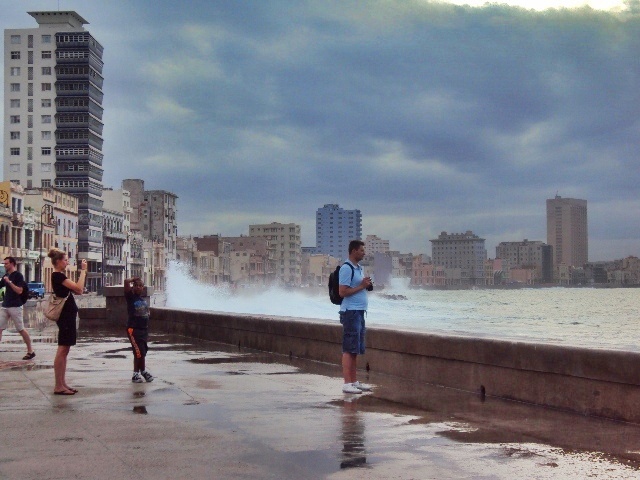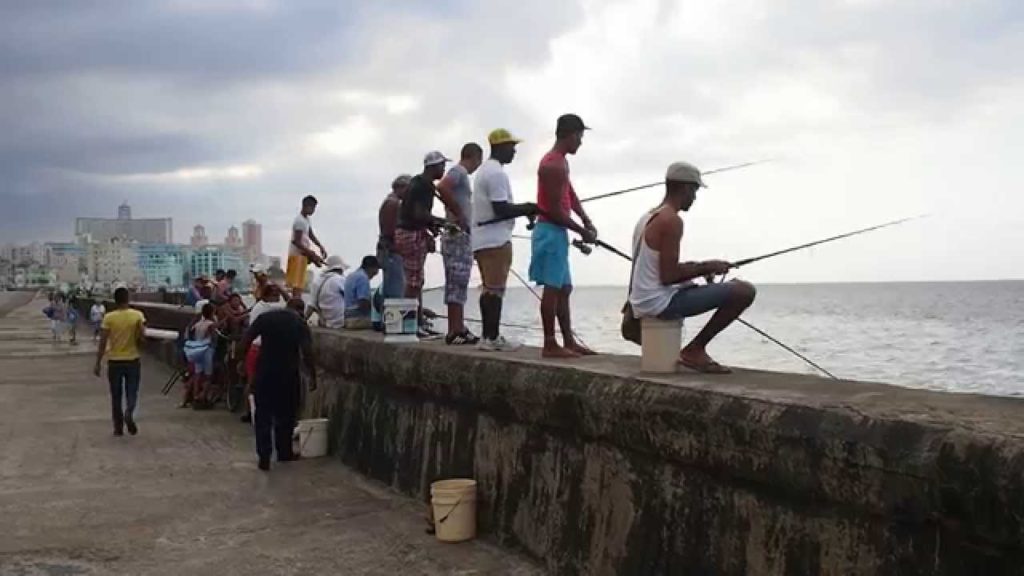LA HABANA Y SU IMPRESCINDIBLE E HISTÓRICO MALECÓN.
La Habana no se concibe sin la Rampa, la escalinata universitaria ni la heladería Coppelia. Tampoco se concibe sin su Malecón, el sitio más cosmopolita de la urbe. Tanta importancia se le da, que ese nombre genérico y que es sinónimo de dique, adquiere aquí categoría de nombre propio y se escribe con letra inicial mayúscula.
La construcción del Malecón comenzó en 1901, durante el gobierno militar temporario de los EE. UU. Y el principal objetivo de la construcción del Malecón era proteger a La Habana del agua y los llamados Nortes, pero en realidad terminaría sirviendo más para los paseos nocturnos de los Habaneros. , para los amantes y sobre todo para los pescadores individuales.
Para celebrar la construcción de la primera sección de 500 metros del Malecón, el gobierno estadounidense construyó una hermosa rotonda en la intersección del Paseo del Prado, que, según los arquitectos de la época, fue la primera construida en Cuba con concreto reforzado con acero.
Son algo más de siete kilómetros de un muro que corre de este a oeste y se extiende entre dos fortalezas coloniales: el castillo de la Punta, al comienzo del Paseo del Prado, y el castillito de La Chorrera, a la vera de la desembocadura del río Almendares. Del lado de acá, la ciudad vieja y nueva, con algunos de sus mejores hoteles, monumentos y parques; del otro lado, el mar abierto, azul, sencillo, democrático, como lo definiera nuestro poeta Nicolás Guillén.
Una transitada avenida lo bordea de extremo a extremo y cada uno de sus cuatro tramos tiene un nombre que lo identifica. Pero para cualquier habanero que se respete, la costanera, a pesar de sus tramos, no tiene más nombre que Malecón, el camino más rápido para conectarse con Miramar y la Marina Hemingway desde La Habana Vieja, y que se convierte durante los carnavales habaneros en la pista de baile más grande del mundo.
Así como no se concibe La Habana sin ese muro y su populosa vía aledaña, no se concibe el Malecón sin sus enamorados y sus pescadores. Desde que hace más de cien años comenzó a construirse esa obra que embelleció la ciudad, los habaneros lo hicieron lugar de preferencia para el paseo. Y parejas de enamorados, acunadas por la brisa marina, acudieron en busca de intimidad: una intimidad que consiguen inexplicablemente aunque casi a su lado se hallen sentadas otras parejas con idéntico propósito. Eso ocurre sobre todo en las noches.
De día, el Malecón es de los pescadores. No se sabe cuándo empezaron a aparecer. Tal vez hayan estado siempre. Los de aquí son, como todos los pescadores del mundo, gente callada, de paciencia infinita, de una constancia y un optimismo dignos de mejor causa y exagerados a más no poder cuando aluden a su ocupación. Aunque las aguas de la zona no están exentas de contaminación, se mantienen habitables para numerosas especies gracias al movimiento incesante de las corrientes: mar afuera, la famosa corriente del Golfo, y, pegada a la tierra, la contracorriente costera, que los marineros españoles llamaron en el pasado la reversa de La Habana por lo difícil que hacía que grandes buques entraran al puerto. Llegan con sus avíos, los despliegan y ¡a pescar! Aunque a veces nada pesquen o cobren solo una pobre captura tras muchas horas de faena bajo un sol de justicia que hace caer barretas encendidas sobre sus cabezas.
No importa. Nada los desanima. Son toda una estirpe. Tienen linaje y nobleza. Son los pescadores del Malecón, y volverán al día siguiente para más de lo mismo. Lo curioso es que a la mayoría de ellos no los alienta el interés material. Solo el gusto por hacer lo que hacen para después comentar con otros pescadores que consiguieron atrapar el peje más grande del mundo que solo existió en su imaginación y en su deseo.
LA HAVANA AND ITS POPULAR AND HISTORICAL MALECÓN. PHOTOS.
Havana is not conceived without the Rampa, the university stairway and the Coppelia ice cream shop. Nor is it conceived without its Malecón, the most cosmopolitan place in the city. So much importance is given, that this generic name and that is synonymous with dike, acquires here a category of its own name and is written with a capital initial letter.
Construction of the Malecón began in 1901, during temporary U.S. military rule and the main purpose of building the Malecón was to protect Havana from the water and the so-called Nortes, but in reality, it would end up serving more for nighttime promenades by Habaneros, for lovers and most of all for individual fishermen.
To celebrate the construction of the first 500m section of the Malecón, the American government built a beautiful roundabout at the intersection of Paseo del Prado, which, according to architects of the period, was the first one built in Cuba with steel-reinforced concrete.
They are more than seven kilometers from a wall that runs from east to west and extends between two colonial fortresses: the castle of Punta, at the beginning of Paseo del Prado, and the castillito of La Chorrera, on the edge of the mouth of the Almendares river. On the other side, the old and new city, with some of its best hotels, monuments and parks; on the other side, the open sea, blue, simple, democratic, as defined by our poet Nicolás Guillén.
A busy avenue borders it from end to end and each of its four sections has a name that identifies it. But for any habanero who respects himself, the waterfront, despite its stretches, has no name but Malecon, the fastest way to connect with Miramar and Marina Hemingway from Old Havana, and which becomes during the Havana carnivals in the biggest dance floor in the world.
Just as Havana is not conceived without this wall and its populous neighboring road, the Malecón is not conceived without its lovers and fishermen. Since more than a hundred years ago that work that embellished the city began to be built, the people of Havana made it the preferred place for the walk. And couples in love, cradled by the sea breeze, went in search of intimacy: an intimacy they get inexplicably, although almost on their side other couples with the same purpose are sitting. That happens mostly at night.
By day, the Malecon is the fishermen’s. It is not known when they began to appear. Maybe they have always been. Those of here are, like all the fishermen of the world, quiet people, of infinite patience, of perseverance and optimism worthy of a better cause and exaggerated as they can not when they allude to their occupation. Although the waters of the area are not free of pollution, they remain habitable for many species thanks to the incessant movement of the currents: the sea outside, the famous Gulf Stream, and, close to the land, the coastal countercurrent, that the Spanish sailors In the past they called the reversal of Havana because of the difficulty in getting large ships to enter the port. They arrive with their accoutrements, deploy them and fish! Although sometimes they do not fish or catch only a poor capture after many hours of work under a sun of justice that makes lighted jumpers fall on their heads.
Does not matter. Nothing discourages them. They are a whole lineage. They have lineage and nobility. They are the fishermen of the Malecón, and they will return the next day for more of the same. The funny thing is that most of them are not encouraged by material interest. Only the pleasure to do what they do and then discuss with other fishermen who managed to catch the biggest peje in the world that only existed in his imagination and his desire.
Agencies/Ciro Bianchi/Wiki/ Internet Photos/ Arnoldo Varona/ theCubanHistory.com
THE CUBAN HISTORY, HOLLYWOOD.











